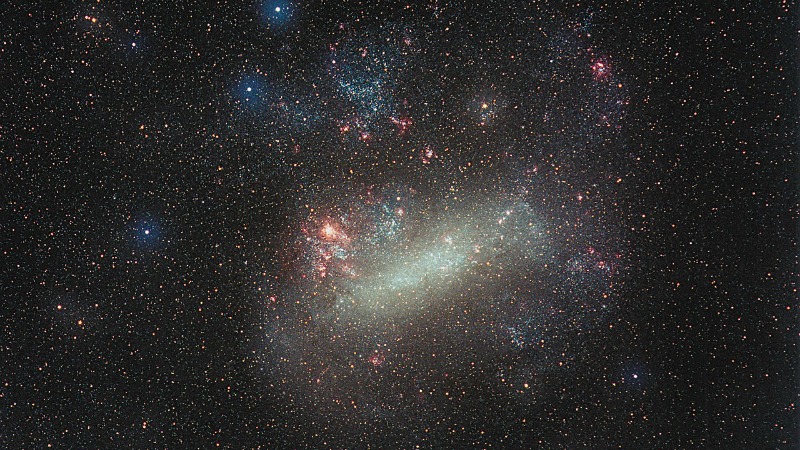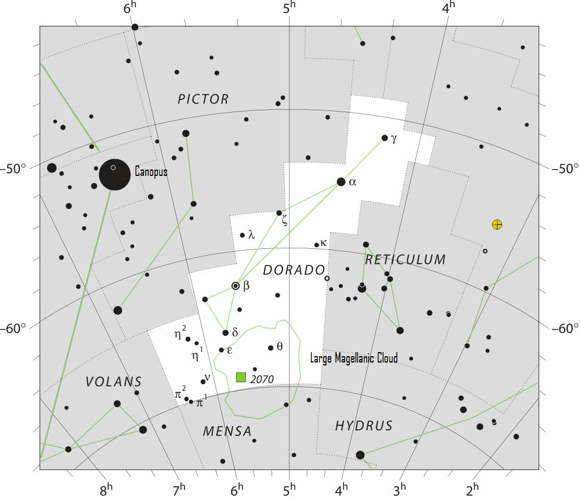

This ground-based image of the Large Magellanic Cloud was taken by German astrophotographer Eckhard Slawik. Image via ESA.
EarthSky lunar calendars are cool! They make great gifts. Order now. Going fast!
The Large Magellanic Cloud (LMC), which is visible to the unaided human eye, is a familiar sight to observers in Earth’s Southern Hemisphere. Along with the Small Magellanic Cloud (SMC), not far from it on our sky’s dome, it looks like nothing so much as a small, faint bit of the Milky Way that has broken off. And yet it is not part of our Milky Way galaxy. It is a separate small galaxy, thought to be orbiting our larger Milky Way.

If you’re far enough south on Earth’s globe, you can star-hop to the Large Magellanic Cloud via the bright stars Sirius (at right) and Canopus (at left). Photo taken at nightfall on May 15, 2013, from Kalgoorlie, Western Australia, by Oliver Floyd. Thank you, Oliver!
How to find the Large Magellanic Cloud. For observers south of about 20 degrees south latitude, the LMC is circumpolar, meaning that it can be seen (at least in part) all night every night of the year, weather permitting.
In the Northern Hemisphere, only observers south of about 20 degrees north latitude can ever see it at all. This excludes North America (except southern Mexico), Europe, northern Africa and northern Asia.

View larger. | The Large Magellanic Cloud is found in the constellations Dorado and Mensa. The nearby star is Canopus.
The LMC is located about 22 degrees from the South Celestial Pole, approximately on the border between the constellations Dorado and Mensa in a region of faint stars. It covers an area of the sky about 9 by 11 degrees, and shines with a total integrated magnitude of approximately zero. If all of its light were concentrated in a starlike pinpoint, it would be one of the brightest stars in the heavens. However, since the light is spread over nearly 100 square degrees, it appears only as a faint smudge.
From tropical latitudes in the Northern Hemisphere, where it still can be observed, the LMC is best seen in the evening from December to April. When the constellation Orion reaches its highest point in the sky, so does the Large Magellanic Cloud. But even at 15 degrees north latitude (the latitude of Central America), the LMC never gets far above the southern horizon.
However, it’s fairly easy to star-hop to this southern treasure by using the two brightest stars in the nighttime sky: Sirius and Canopus. Draw a line from Sirius and past the right side of Canopus to descend to the LMC. Our sky chart is designed for about 15 degrees north. Farther south, the LMC sits higher in the southern sky.
History and myth of the Large Magellanic Cloud. Being so far south on the sky’s dome, the Large Magellanic Cloud was not known in classical northern mythology at all. Understandably, it factors better for observers in the Southern Hemisphere. The nearby constellation, Mensa (“Table”), originally was named after South Africa’s Table Mountain, and a story from that country equates the Large Magellanic Cloud with a puff of smoke from a pipe-smoking contest held on the mountain. Australian Aboriginal storytellers relate that the LMC is the campsite of an old man, whereas the Small Magellanic Cloud (SMC) is the campsite of his wife. The couple, known jointly as Jukara, had grown too old to feed themselves, so other star beings bring them fish from the sky river we know as the Milky Way.
The European “discovery” of the LMC and SMC is attributed to explorer Ferdinand Magellan, although such obvious heavenly bodies certainly were seen before.
Large Magellanic Cloud as captured by astrophotographer Justin Ng of Singapore. Justin was at Mount Bromo, an active volcano in East Java, Indonesia, when he took this photo.
Science of the Large Magellanic Cloud. After two smaller galaxies not visible to the human eye, the LMC is the third closest galaxy to the Milky Way, and in fact is thought by most astronomers to be orbiting the Milky Way.
Although there is some uncertainty due to various methods of distance determination, the best current estimate puts the LMC at 150,000 to about 160,000 light-years away, or about five or six times as far from Earth as Earth is from the center of the Milky Way. Other estimates have it as far as 180,000 light-years.
Its shape suggests a transitional form between a small spiral galaxy and an irregular galaxy. About 30,000 light-years across in the longest dimension, it appears from Earth more than 20 times the width of a full moon.
Estimates vary from a few billion to perhaps 10 billion stars in this galaxy, at best no more than about one-tenth the mass of the Milky Way.
The center of the LMC is approximately RA: 5h 23m 35s, dec: -69° 45’22”
Nearly 200 000 light-years from Earth, the Large Magellanic Cloud, a satellite galaxy of the Milky Way, floats in space in a long and slow dance around our galaxy. As the Milky Way’s gravity gently tugs on its neighbor’s gas clouds, they collapse to form new stars. In turn, these light up the gas clouds in a kaleidoscope of colors, visible in this image from the Hubble Space Telescope. Image via ESA/NASA/Hubble.
Bottom line: From tropical latitudes in the Northern Hemisphere, where it can be observed, the Large Magellanic Cloud is best seen in the evening from December to April. From the Southern Hemisphere, it’s easy to see and spectacular!
from EarthSky https://ift.tt/2BQ868K


This ground-based image of the Large Magellanic Cloud was taken by German astrophotographer Eckhard Slawik. Image via ESA.
EarthSky lunar calendars are cool! They make great gifts. Order now. Going fast!
The Large Magellanic Cloud (LMC), which is visible to the unaided human eye, is a familiar sight to observers in Earth’s Southern Hemisphere. Along with the Small Magellanic Cloud (SMC), not far from it on our sky’s dome, it looks like nothing so much as a small, faint bit of the Milky Way that has broken off. And yet it is not part of our Milky Way galaxy. It is a separate small galaxy, thought to be orbiting our larger Milky Way.

If you’re far enough south on Earth’s globe, you can star-hop to the Large Magellanic Cloud via the bright stars Sirius (at right) and Canopus (at left). Photo taken at nightfall on May 15, 2013, from Kalgoorlie, Western Australia, by Oliver Floyd. Thank you, Oliver!
How to find the Large Magellanic Cloud. For observers south of about 20 degrees south latitude, the LMC is circumpolar, meaning that it can be seen (at least in part) all night every night of the year, weather permitting.
In the Northern Hemisphere, only observers south of about 20 degrees north latitude can ever see it at all. This excludes North America (except southern Mexico), Europe, northern Africa and northern Asia.

View larger. | The Large Magellanic Cloud is found in the constellations Dorado and Mensa. The nearby star is Canopus.
The LMC is located about 22 degrees from the South Celestial Pole, approximately on the border between the constellations Dorado and Mensa in a region of faint stars. It covers an area of the sky about 9 by 11 degrees, and shines with a total integrated magnitude of approximately zero. If all of its light were concentrated in a starlike pinpoint, it would be one of the brightest stars in the heavens. However, since the light is spread over nearly 100 square degrees, it appears only as a faint smudge.
From tropical latitudes in the Northern Hemisphere, where it still can be observed, the LMC is best seen in the evening from December to April. When the constellation Orion reaches its highest point in the sky, so does the Large Magellanic Cloud. But even at 15 degrees north latitude (the latitude of Central America), the LMC never gets far above the southern horizon.
However, it’s fairly easy to star-hop to this southern treasure by using the two brightest stars in the nighttime sky: Sirius and Canopus. Draw a line from Sirius and past the right side of Canopus to descend to the LMC. Our sky chart is designed for about 15 degrees north. Farther south, the LMC sits higher in the southern sky.
History and myth of the Large Magellanic Cloud. Being so far south on the sky’s dome, the Large Magellanic Cloud was not known in classical northern mythology at all. Understandably, it factors better for observers in the Southern Hemisphere. The nearby constellation, Mensa (“Table”), originally was named after South Africa’s Table Mountain, and a story from that country equates the Large Magellanic Cloud with a puff of smoke from a pipe-smoking contest held on the mountain. Australian Aboriginal storytellers relate that the LMC is the campsite of an old man, whereas the Small Magellanic Cloud (SMC) is the campsite of his wife. The couple, known jointly as Jukara, had grown too old to feed themselves, so other star beings bring them fish from the sky river we know as the Milky Way.
The European “discovery” of the LMC and SMC is attributed to explorer Ferdinand Magellan, although such obvious heavenly bodies certainly were seen before.
Large Magellanic Cloud as captured by astrophotographer Justin Ng of Singapore. Justin was at Mount Bromo, an active volcano in East Java, Indonesia, when he took this photo.
Science of the Large Magellanic Cloud. After two smaller galaxies not visible to the human eye, the LMC is the third closest galaxy to the Milky Way, and in fact is thought by most astronomers to be orbiting the Milky Way.
Although there is some uncertainty due to various methods of distance determination, the best current estimate puts the LMC at 150,000 to about 160,000 light-years away, or about five or six times as far from Earth as Earth is from the center of the Milky Way. Other estimates have it as far as 180,000 light-years.
Its shape suggests a transitional form between a small spiral galaxy and an irregular galaxy. About 30,000 light-years across in the longest dimension, it appears from Earth more than 20 times the width of a full moon.
Estimates vary from a few billion to perhaps 10 billion stars in this galaxy, at best no more than about one-tenth the mass of the Milky Way.
The center of the LMC is approximately RA: 5h 23m 35s, dec: -69° 45’22”
Nearly 200 000 light-years from Earth, the Large Magellanic Cloud, a satellite galaxy of the Milky Way, floats in space in a long and slow dance around our galaxy. As the Milky Way’s gravity gently tugs on its neighbor’s gas clouds, they collapse to form new stars. In turn, these light up the gas clouds in a kaleidoscope of colors, visible in this image from the Hubble Space Telescope. Image via ESA/NASA/Hubble.
Bottom line: From tropical latitudes in the Northern Hemisphere, where it can be observed, the Large Magellanic Cloud is best seen in the evening from December to April. From the Southern Hemisphere, it’s easy to see and spectacular!
from EarthSky https://ift.tt/2BQ868K


Aucun commentaire:
Enregistrer un commentaire